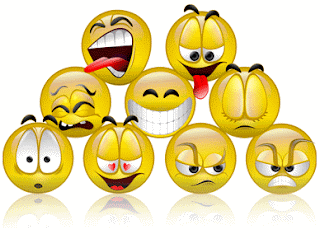Invention
The smiley face, a yellow button with a smile and two dots representing eyes was invented by Harvey Ball in 1963 for Worcester, Massachusetts based insurance firm State Mutual Life Assurance. Though there was an attempt to trademark the image, it fell into the public domain before that could be accomplished.
The graphic was popularized in the early 1970s by a pair of brothers, Murray and Bernard Spain, who seized upon it in a campaign to sell novelty items. The two produced buttons as well as coffee mugs, t-shirts, bumper stickers and many other items emblazoned with the symbol and the phrase "Have a happy day" (devised by Murray). By 1972 there were an estimated 50 million happy face buttons throughout the U.S., at which point the fad began to subside.
The symbol has been satirized with a smile and three dots (a mutant), and has been reborn as the image of the Microsoft Bob software and Walmart's price cutting ads.
Smileys on the Internet
In the context of the Internet, "smiley" sometimes means the same as "emoticon" (a short string of characters representing a human face) but more frequently means an emoticon that represents a smiling human face. Smileys are usually used in email messages or in chat. To more easily recognise them, put your head on your left shoulder. The first known recorded instance of an ASCII smiley occurred on September 19, 1982 on an online bulletin board, when Scott Fahlman, a researcher at IBM, suggested the emoticon after an online joke caused a false alarm and a discussion ensued in response, about the need for markers for humorous comments. (Other suggestions included +, %, &, (#) and --/.)
Some basic examples:
:-) is a smile ;-) is winking :'-( is crying :-9 is whistling B-) or 8-) has (sun)glasses @@@@@@@:-) Marge Simpson :D or :> Open mouthed smiley :-O Surprised smiley :P Smiley with tongue :@ Angry smiley :S Confused smiley :$ Embarassed Smiley 8-| Nerd smiley ^o) Sarcastic smiley *-) Thinking Smiley :-x Don't tell anyone smileyIn Japan, smilies are read vertically as opposed to the horizontally read smilies of the west, the most common one being (^_^) . They sometimes contain visual imagery that is common is Japanese manga and anime.
Some basic Japanese smilies:
^_^ Basic smilie (Japanese symbol) ;_; Crying smilie (Japanese symbol) *^_^* Cute little girl / Blushing smilie (Japanese symbol) ^_^;;; Embarassed smilie; cold sweat (Japanese symbol) (^o^) User is joyously singing (sideways) (-.-)Zzz... Sleeping (sideways) (^.^)/ User is waving hello (sideways, Japanese style)There are a lot of possibilities, people are very good at interpreting pictures as smiles. See ASCII art and emoticon.
Smileys in Club Culture
The smiley was one of the main icons adopted by the dance music culture that emerged in the early 1990s. Especially in the UK, the logo was especially associated in the dance culture underground with the drug Ecstasy.Smiley Bomber
Luke Helder, midwestern pipe-bomber in May 2002 tried to replicate a smiley face in his pattern of pipe bombs. His first 16 bombs formed circles, the first in Nebraska and the second on the border between Illinois and Iowa. Those bombs completed the eyes. Two other bombs in Texas and Colorado were apparently the beginnings of the smile. However, he was captured before he completed the smile itself.Smileys in Cinematography
- The film Forrest Gump (Robert Zemeckis, 1994) remembered the Smiley with a humorous reference.
- The film Fight Club (David Fincher, 1999) has a brief "smiley bombing" scene on the side of an office building.
Other Smileys
- George Smiley is the protagonist of a series of novels by John Le Carre, including Tinker, Tailor, Soldier, Spy, and TV series adapted from them.
- Guy Smiley was a 1970s Muppet game show host on Sesame Street.



It's amazing how 'advanced' smilies have gotten ;-)
ReplyDeleteThanks for the interesting post!